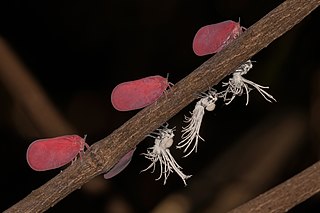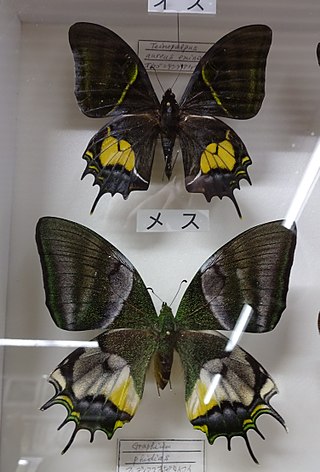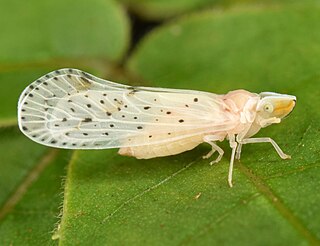
Phoenix dactylifera, commonly known as the date palm, is a flowering-plant species in the palm family Arecaceae, cultivated for its edible sweet fruit called dates. The species is widely cultivated across northern Africa, the Middle East, the Horn of Africa, Australia, South Asia, and California. It is naturalized in many tropical and subtropical regions worldwide. P. dactylifera is the type species of genus Phoenix, which contains 12–19 species of wild date palms.
Victor Loche (1806–1863) was a French soldier and naturalist.

Louis Alexandre Auguste Chevrolat was a French entomologist. He specialized mainly on the beetles and was a founder of the Societe entomologique de France in 1832.

A planthopper is any insect in the infraorder Fulgoromorpha, in the suborder Auchenorrhyncha, a group exceeding 12,500 described species worldwide. The name comes from their remarkable resemblance to leaves and other plants of their environment and that they often "hop" for quick transportation in a similar way to that of grasshoppers. However, planthoppers generally walk very slowly. Distributed worldwide, all members of this group are plant-feeders, though few are considered pests. Fulgoromorphs are most reliably distinguished from the other Auchenorrhyncha by two features; the bifurcate (Y-shaped) anal vein in the forewing, and the thickened, three-segmented antennae, with a generally round or egg-shaped second segment (pedicel) that bears a fine filamentous arista.

Pousargues's mongoose, also known as the African tropical savannah mongoose, is a mongoose native to Central Africa. It is listed as data deficient on the IUCN Red List as little is known about its distribution and ecology. It is the only species in the genus Dologale.
Jean Baptiste Lucien Buquet was a French entomologist and insect dealer mainly interested in Coleoptera. He described many new genera and species. Buquet's business dealt in exotic Coleoptera, especially Buprestidae, Lucanidae, Scarabaeidae and Cerambycidae. He also sold Lepidoptera, especially Morpho and Agrias. The insects came mainly from the French colonial empires. He was a member of the Société entomologique de France.

Teinopalpus aureus, the golden Kaiser-i-Hind, is a species of butterfly in the family Papilionidae. It is found in China and possibly Vietnam. Considered an endangered species threatened by the wildlife trade, it is protected by Chinese law. Species distribution models show that montane forests in mid to high elevations within Southern China, Laos, and Vietnam are suitable habitats of T. aureus. However, they have poorly connected habitat networks and many of these areas are facing deforestation and severe climate change effects.

Madagasikara madagascarensis s a species of tropical freshwater snail with a gill and an operculum, an aquatic gastropod mollusc in the family Pachychilidae.
Haemanota is a genus of moths in the family Erebidae. The genus was erected by George Hampson in 1901.

The family Derbidae is a large and diverse group of planthoppers, widely distributed in the tropics and also found in subtropical and temperate regions. It includes more than 150 genera and more than 1500 species. The adults suck the sap of plants while the nymphs live mainly in decaying organic matter, for example under the bark of dead tree trunks, feeding on fungi. In some groups of species the general structure of the insects is largely uniform, whereas in others like in the subfamily Otiocerinae various forms can be found. For example, the shape of the head, the antennae or the wings can differ considerably among genera and species.

Oryctes is the economically most important genus of rhinoceros beetles in the subfamily Dynastinae and includes serious pests of palm trees. A total of 47 species have been assigned to the genus, including 2 fossil ones. The extant species are widely distributed in Africa, as well as in Europe, Asia and the Pacific. No established populations are known from the Americas. The species are typically between 30 and 60 mm long, dark brown to black, with a robust body and a strong cuticle. They can be distinguished from other genera in the tribe Oryctini by the structure of the pronotum, the horn on the head, the mouthparts and other features.

Pierre Chrétien was a French entomologist who specialised in Lepidoptera. He was a member of Société entomologique de France. Trifurcula chretieniZ. & A. Lastuvka & van Nieukerken, 2013 is "named in honour of Pierre Chrétien (1846–1934), who discovered nepticulid mines on Bupleurum, including those on Bupleurum rigidum, and the first author to describe a number of Mediterranean species that are now placed in Trifurcula (Glaucolepis)." His collection is held by National Museum of Natural History in Paris.
Alexandre Pierret was a French entomologist who specialised in Lepidoptera. He was a Member of the Société Entomologique de France
Uvariopsis korupensis is a species of flowering plant in the family Annonaceae endemic to Cameroon.
Uvariopsis zenkeri Engl. is a species of flowering shrub in the family Annonaceae endemic to Cameroon and the Central African Republic.

Tropiduchinae is a subfamily of tropiduchid planthoppers in the family Tropiduchidae.

Elicinae is a subfamily of tropiduchid planthoppers in the family Tropiduchidae, with Elica the type genus.

Ommatissus is a genus of bugs in the subfamily Tropiduchinae and the tribe Trypetimorphini.

Dundubia is a genus of cicadas in the subfamily Cicadinae and the type genus of the tribe Dundubiini.
Egregia is a genus of planthoppers in the family Fulgoridae, subfamily Aphaeninae. Species are distributed in Malesia. As of 2020, the number of species increased to 24.















